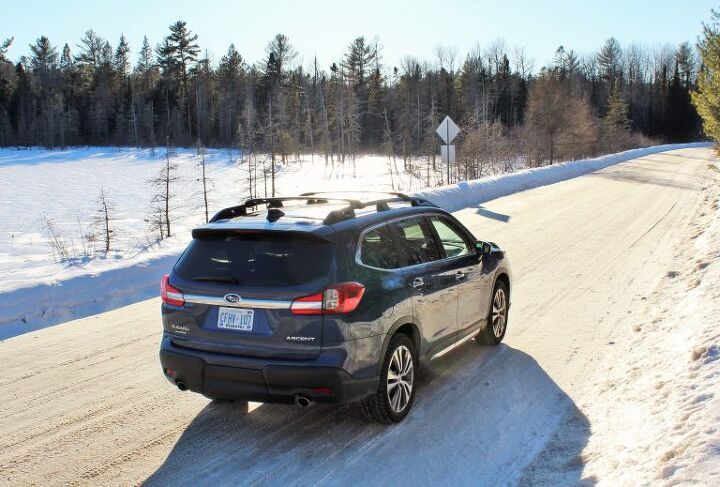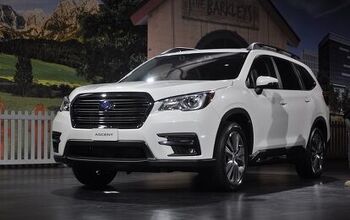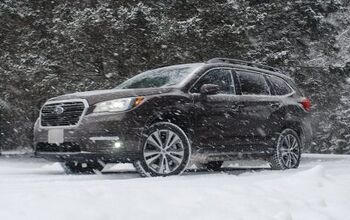2019 Subaru Ascent Premier Review - In a Big Country

2019 Subaru Ascent Premier
Approaching my Ascent tester behind a not-so-local dealer, I felt a presence. Like a pre-war bank, this thing was solid, monolithic, immovable, looming over all of humanity and granting entry to only a choice few. Given the profit Subaru’s going to make off these things, it’s not an inaccurate comparison.
The last Subaru I drove was an Impreza. Not a WRX or its hotter sister, but a stock Impreza sedan. You don’t see many of them. Before that, it was a Crosstrek. Or was it a Forester? No matter, really. Before that, it was a friend’s short-lived SVX, some 16 or so years ago.
Compared to those compact rides, the midsize Ascent crossover is like the HMS Dreadnought moored alongside a torpedo boat, and that’s exactly what Americans — or what Subaru thinks Americans — want. Thankfully, having found myself behind the wheel of a great number of crossovers of late, the Ascent at least held some quirks to set itself apart.
I know, I know, Matthew Guy covered much of this same ground not long ago in his Ascent review, but two observations are better than one. Bear with me!
Easing the Ascent’s bulk out onto a disgustingly slush-filled February street, the crossover’s firm and supportive seats positively oozed Subaru; it’s a comfort I’ve come to expect from the brand, and it’s one I appreciate. Owners won’t want for coddling. It helps that this was a top-flight Premier (the equivalent of a Touring trim in the U.S.) decked out with every last bell and whistle; rich brown leather covering the seven chairs (larger broods can order eight), EyeSight driver assist features up the wazoo, and, of course, the sense of invulnerability afforded by a high-riding perch.
Get new and used Subaru Ascent pricing here!
In high-speed highway driving, the Ascent’s steering felt … effortless. A little too effortless. Searching in vain for a sport mode button or knob to firm things up, I realized this vehicle’s mission. It isn’t meant to thrill moms and dads on the nights the kids are at their grandparents, or even impress the less aged coworkers at their office. It isn’t meant to get the younger crowd hot under the collar at the idea of buying a crossover. The pretense of sportiness seen with so many other vehicles in this category? Absent. No, the Ascent is just a lot of rolling space. Capable, well buttoned-up space that’s easy for anyone to drive, regardless of arm strength.
Basically, Job One for any crossover. It’s easy to forget that Subaru’s a newbie to the midsize segment.
In a burst of equity, Subaru offers but one powertrain in the Ascent, regardless of trim, and it’s an unusual one — a turbocharged 2.4-liter boxer four, good for 260 hp and 277 lb-ft of torque, mated to a continuously variable transmission. In a fairly homogeneous field, Subaru offered something different under the hood.
And there’s nothing wrong with that, except for the fact that the engine’s fairly noisy, and only in a good way after the thing really warms up. It was frigid the week I had the Ascent, and taking off after a cold startup prompted the same intrusive CVT whine Mr. Guy complained about. On one particularly vortex-plagued morning, the tranny acted like a conventional autobox that couldn’t get out of first gear.
Would the revs ever drop? I waited with baited breath.
On warmer days, the boxer’s truck-like rumble stirred something primal in this driver’s psyche, though buyers of vehicles with a similar price tag would probably demand a little more sound-deadening insulation with their ride.
It snowed that week, too. Oh God, did it snow, and it was in this inclimate weather that time spent behind the Ascent’s wheel entered the realm of “fun.” Subaru’s ever-present symmetrical full-time all-wheel drive (was there ever an automotive term burned so deeply into the public consciousness?) ensured that its largest model is just as adept at tackling the white stuff as any other of the brand’s offerings, blasting through snow like a record producer and not afraid to get a little tail happy when urged. Flappy paddles — the only nod to performance in sight — came in handy on the wintry backroads, through I wasn’t able to find any inclines steep enough to give drivetrain-nannying X-Mode (with Hill Descent) a whirl.
While there’s no chance of heart palpitations during acceleration and passing maneuvers, your average Ascent owner likely won’t find its power lacking, nor will they find much to gripe about on rough roads. As always, taller sidewalls would have helped soften the blow of urban cracks and crevasses, but alas, loaded press fleet crossovers call for 20-inchers — even in winter.
Further evidence of this vehicle’s true purpose can be found in the fact the Ascent, regardless of trim, has not four, not eight, not 12, but 19 cupholders. America! The Beverage King Ascent clearly does not wish to see occupants grow dehydrated during long road trips. Entertainment won’t be an issue, either — at least, not in this high-zoot trim level, where every occupant has access to a USB port. There’s enough connection points of various types in the Ascent’s cabin to keep an FBI surveillance team humming away for hours.
It’s nice that Subaru went with a fairly stodgy profile for its big guy, otherwise I’d have grazed my scalp while sitting in the back row. Didn’t happen here. I was pleased to find climate vents back there, too, as third-row occupants needn’t adopt the role of steerage-class passengers in a coming-to-America film.
While Subaru’s two-screen center stack presents a familiar sight in the Ascent, another quirk quickly made itself known. On an undulating freeway, the crossover’s light steering (it starts to tighten up over 40 mph, but not enough for my liking) left me feeling uneasy. Time to bolster the defences. Unfortunately, a cursory scan of the steering wheel and dash showed no trace of a lane-hold switch in all the usual hangouts. It was only after I exited the freeway and stopped at a light did I discover the little scamp hiding above my head, near the sunglasses holder.
Subaru does a good job creating a rich-feeling, semi-premium cabin, and the model’s capability in bad weather and backcountry shouldn’t be a matter of doubt. I only wish I had a chance to test it in summer, if only to gauge its fuel economy. Despite its four-cylinder powerplant, the cold weather, soft winter rubber, and excessive idling (defrosting can take time) all conspired to return a combined figure of 15.7 mpg for the week. The EPA rates it at 22 mpg combined.
The verdict? A solid effort from Subaru — it’s a vehicle that gets the basics right, minor quibbles aside. However, if you can live without a panoramic sunroof, 20-inch wheels, stereo upgrade, and ultra-sumptuous seats, you might find the purchase of a lower-trim Ascent easier to rationalize.
[Images: Steph Willems/TTAC]

More by Steph Willems
Latest Car Reviews
Read moreLatest Product Reviews
Read moreRecent Comments
- MaintenanceCosts You expect everything on Amazon and eBay to be fake, but it's a shame to see fake stuff on Summit Racing. Glad they pulled it.
- SCE to AUX 08 Rabbit (college car, 128k miles): Everything is expensive and difficult to repair. Bought it several years ago as a favor to a friend leaving the country. I outsourced the clutch ($1200), but I did all other work. Ignition switch, all calipers, pads, rotors, A/C compressor, blower fan, cooling fan, plugs and coils, belts and tensioners, 3 flat tires (nails), and on and on.19 Ioniq EV (66k miles): 12V battery, wipers, 1 set of tires, cabin air filter, new pads and rotors at 15k miles since the factory ones wore funny, 1 qt of reduction gear oil. Insurance is cheap. It costs me nearly nothing to drive it.22 Santa Fe (22k miles): Nothing yet, except oil changes. I dread having to buy tires.
- AZFelix 2015 Sonata Limited72k when purchased, 176k miles currentlyI perform all maintenance and repairs except for alignment, tire mounting, tire patching, and glass work (tint and passenger left due to rock hit). Most parts purchased through rockauto.com.Maintenance and repairs during three years of ownership:Front rotors and all brake pads upgraded shortly after purchase.Preparing for 17th oil change (full synthetic plus filter c.$50), one PCV valve.Timing & accessory belts, belt tensioner.Coolant full flush and change.Fibrous plastic material engine under tray replaced by aftermarket solid plastic piece $110.One set of tires (c.$500 +installation) plus two replacements and a number of patches due to nails, etc. Second set coming soon.Hood struts $30.Front struts, rear shocks, plus sway bar links, front ball joints, tie rod ends, right CV axle (large rock on freeway damaged it and I took the opportunity to redo the rest of items on this list).Battery c.$260.Two sets of spark plugs @ $50/set.Three sets of cabin and engine filters.Valve cover gasket (next week).Averages out to c.$1400 per year for the past three years. Minor driver seat bolster wear, front rock chips, and assorted dents & dings but otherwise looks and drives very well.
- 3-On-The-Tree 2014 Ford F150 Ecoboost 3.5L. By 80,000mi I had to have the rear main oil seal replaced twice. Driver side turbo leaking had to have all hoses replaced. Passenger side turbo had to be completely replaced. Engine timing chain front cover leak had to be replaced. Transmission front pump leak had to be removed and replaced. Ford renewed my faith in Extended warranty’s because luckily I had one and used it to the fullest. Sold that truck on caravan and got me a 2021 Tundra Crewmax 4x4. Not a fan of turbos and I will never own a Ford again much less cars with turbos to include newer Toyotas. And I’m a Toyota guy.
- Duke Woolworth Weight 4800# as I recall.







































Comments
Join the conversation
In the pix it looks like this has a lower floor than most CUVs. Did they reclaim those vertical inches for interior room? Looks like they kept the pointless body lift to a minimum too. Is the hip height a little lower than other CUVs and does that pay off in cornering stability? CUVs are station wagons. Subaru seems to be making minimal effort to pretend otherwise, and I applaud that. The one exception is the front third of the car --- engine compartment and fenders -- which is way too tall, looking ungainly and compromising visibility for nothing. A boxer takes up very little vertical real estate, so there's no practical reason for this.
An old friend of mine recently bought one of these in a lower trim level. His MPG is not far off what you recorded this Winter with the average coming in around 16. In the warmer months that figure climbs to around 19-19.5 so 22 combined is a stretch unless more highway miles is calculated in of course. Tall heavy boxes on large diameter wheels conspire to give not so great MPG despite the cylinder count and trick CVT transmissions. He has had to take it in for an Air bag warning light that would come on randomly while driving and his bluetooth connection has been troublesome but otherwise he seems to like it.